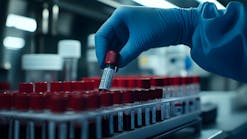Question: How can a lab acquire new instrumentation in an era of cost cutting?
Answer: Here’s how one did it.
Laboratories that want to stay on the cutting edge of technology and service face the constant challenge of maintaining the best equipment possible. In many cases this includes finding analyzers with the latest testing methods, best precision, and greatest potential for growth, while at the same time maintaining customer satisfaction and staying within budget.
Children’s Medical Center of Dallas (CMC) recently found itself confronted with a prime example of this when it needed to acquire an automated analyzer with better sensitivity and accuracy for testing tacrolimus and cyclosporine. Physicians had expressed dissatisfaction with the lack of precise results from the Center’s chemistry analyzer. CMC defined its goal as not only improving customer satisfaction via better methodology, but also selecting a new analyzer that had the potential for adding additional tests. After careful planning and research, CMC found an available machine that could satisfy those needs: the Abbott Architect i1000 analyzer. In reporting to readers of MLO the path we took in choosing and implementing this instrument, we focus on four related considerations: the analyzer’s test menu; the process involved in acquiring it; the process of implementation; and the success of implementation.
The analyzer’s test menu
The instrument chosen was an immunoassay analyzer designed for low-to-mid-volume testing. Additionally, the assays for transplant drugs were also FDA-approved, while assays from other vendors with new instruments were still in development.1 We discovered that other platforms had new methods under development which showed to be imprecise and inaccurate at low levels. Our patient population consists entirely of children, and smaller patients equate to smaller dosage levels, so that was a crucial aspect when choosing an instrument.
As noted, the major test driving the urge to improve testing quality was tacrolimus, also known as FK 506, which is an immunosuppressive drug designed to increase patient survival of renal and liver transplants.2 Additionally, CMC also tests cyclosporine and sirolimus on the newly acquired instrument as part of its therapeutic drug monitoring (TDM) menu in order to ensure that the correct drug level is obtained in order to reduce the risk of toxicity and the risk of rejection.3 The correct level can change in patients due to pharmacokinetic variability, acute infection, or noncompliance.2 CMC also currently utilizes the instrument’s ability to run the latest generation of HIV testing with a more sensitive assay. The newly purchased equipment is currently the only FDA-approved fourth generation HIV Ag/Ab combo assay.4 Thus, the analyzer will also allow CMC to expand its test menu to include Anti-TPO, Anti-TG, DHEA, estradiol, and folate in the future. Also, upon FDA approval, CMC will be able to consolidate instruments by moving methotrexate from the outdated TDX/FLX. 1The process of acquisition
In today’s healthcare environment, budget cuts are rampant, so any purchase of a new instrument must have approved justification. For the purchase of the Architect analyzer, the overarching justification was the improvement of quality testing, which in turn would improve the quality of patient care. Unfortunately, previous methods of testing on the older platform had not provided the reproducibility and accuracy that the transplant physicians needed to prescribe the most accurate dose of anti-rejection medication.1 The lack of confidence had become so severe that physicians were requesting samples to be sent out for confirmation, leading to an increase in cost as well as turnaround time. According to reproducibility studies performed at CMC, the previous analyzer had a 30% variability, which resulted in unnecessary dosing adjustments, longer stays, increased testing frequency, and higher pharmacy costs.1 As shown in Figure 1, the new instrument tested with more acceptable precision. Justification was also enhanced by the successful implementation of the newly acquired instrument in neighboring hospitals.
Purchasing the new platform was also made easier by the cost benefits that were associated with the instrument and the test menu. According to CMC, the gross revenue from testing tacrolimus generated over $4.2 million in 2010.1 Maintaining the trust of physicians with better instrumentation was essential to prevent the loss of revenue caused by sending out the TDM tests. Also of importance was the fact that the analyzer was significantly less expensive compared to its closest competitor. In addition, we estimated that future testing of new assays on the instrument would reduce the referral budget by $20,000 annually.1
The process of implementation
Once the instrument was approved and purchased, the steps of implementation brought about new challenges. For example, the instrument requires a pretreatment for all whole blood samples, which includes tacrolimus, cyclosporine, and sirolimus. Because of the added steps involved in running each level of QC and each patient sample, the laboratory decided to move from a 24/7 test availability to batch testing, three times between 8 a.m. and 5 p.m. However, the change in availability still satisfied the transplant physicians, because they have stated a preference for precision and accuracy over a rapid turnaround of results.1
Figure 1. Comparison of tacrolimus results from two separate patients over
the course of three collections. The Abbott Architect i1000sr gave more
consistent results than our previous analyzer, the Dimension RxL Max
Another change implemented by the new testing method was the volume of sample required. While previous methods required less than 50 microliters of whole blood, which was easily obtained from a shared sample from an EDTA purple top, the newly implemented instrument required a minimum of 200 microliters due to the additional pretreatment step. At first glance, this may appear to be a minor detail; however, in a children’s hospital, where blood draw volume is limited, this is an important adjustment. Consequently, transplant drug monitoring tests are now required to be drawn in a separate EDTA tube. Sharing with other tests that require EDTA tubes is strongly discouraged because it might create a much higher probability that some of the tests will be quantity insufficient.
The final challenge that presented itself was the need to decide who would run the analyzer. The analyzer was purchased with the expectation that it would not require an additional FTE; thus this became a hurdle to overcome. To compound the problem, at the time of implementation the laboratory was short-staffed. Thus, various duties of certain areas had to be rearranged in order to incorporate the new responsibilities. That said, due to the recent incorporation of Lean procedures in our lab, testing has been successful.
Success of implementation
Fortunately, the implementation of the new instrument has been a success for everyone involved. The laboratory has been able to keep the testing in house and greatly improve the reliability of the transplant drug results. CMC transplant physicians are happier with the new testing method and appreciate the effort made by the lab to maintain the highest quality possible. Patients may not understand everything that has gone on behind the scenes, but they are happier to receive a more accurate dosage that can translate into less time spent in the hospital. Success was not achieved, however, without a few bumps along the way. One of the more challenging aspects included—and continues to include—the need to rearrange the medical technologists’ duties without compromising quality in other areas of the laboratory. That has turned into a positive, however, because it has helped to create a better sense of teamwork in the laboratory.
It is also important to note that additional challenges must be overcome because the analyzer is not fully integrated into the laboratory information system (LIS) yet, which prevents the process from being as streamlined as it will be. However, as long as the customers’ needs are being met and quality remains a top priority, the new analyzer can be judged a success.
In conclusion
Approval for new equipment can be a difficult and tedious process in any economy, especially one that necessitates numerous budget cuts and workforce shortages. Nevertheless, labs cannot afford to sacrifice quality when it comes to patients’ health and treatment. Hence, CMC’s addition of a new analyzer gained approval because quality and patient care were the priority. Not every lab seeking a new analyzer will make the choice we made, as differing needs and changing options will come into play; our purpose is not to promote a particular product or vendor. Rather, it is to show how the staff of CMS confronted a challenge that other laboratorians reading MLO may also face. For us, the newly acquired platform was the best choice in terms of quality and affordability, and we are pleased with it. And, as with any victory in healthcare, the real winners are the patients.
Reference
- York C. Abbott i1000 for tacrolimus. A3 proposal for new analyzer. 2010. Retrieved from Children’s Medical Center of Dallas.
- Wong SH. Therapeutic drug monitoring for immunosuppressants. Clin Chim Acta. 2001;313(1-2):241-253. http://www.ncbi.nlm.nih.gov/pubmed/11694265 Accessed February 27, 2012.
- Zakowski J. Trends in therapeutic monitoring of immunosuppressive drugs. MLO. 2007;39(7):31-32. www.mlo-online.com/articles/0707/0707clinical_issues2.pdf. Accessed February 27, 2012.
- Galbraith JW. Fourth generation HIV tests. 2011. http://emedicine.medscape.comarticle/1982802-overview#showall Accessed February 27, 2012.





